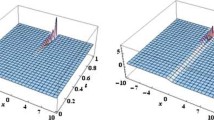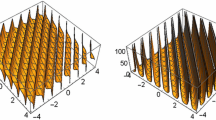Abstract
This paper points out the fractional complex transform method for wave equations on Cantor sets within the local differential fractional operators. The proposed method is efficient to handle differential equations on Cantor sets.
Similar content being viewed by others
1 Introduction
In recent years, the local fractional calculus has attracted a lot of interest for scientists and engineers. Several sections of local fractional derivative had been introduced, i.e. the local fractional derivative structured by Kolwankar and Gangal [1–5], the modified Riemann-Liouville derivative given by Jumarie [3–7], the fractal derivative suggested by Parvate and Gangal [3–5, 8, 9], the fractal derivative considered by Chen et al. [3–5, 10–12], the generalized fractal derivative proposed Chen et al. [12], the local fractional derivative presented by Adda and Cresson [3–5, 13], the fractal derivative suggested by He [3–5, 14–16] and the local fractional derivative structured in [3–5, 17–25]. As a result, the local fractional calculus theory become important for modelling problems for fractal mathematics and engineering on Cantor sets and it plays a key role in many applications in several fields such as the theorical physics [2, 3], the heat conduction theory [3, 14, 17], the fracture and elasticity mechanics [3, 19], the fluid mechanics [3, 26], signal analysis [4, 5], Fourier and wavelet analysis [4, 5], tensor analysis [3], complex analysis [4, 5], optimization method [3] and so on. For example, the local fractional Fokker-Planck equation was proposed in [2]. The fractal heat conduction problems were presented [3, 14]. The principles of virtual work, minimum potential and complementary energy in the mechanics of fractal media were investigated in [3, 19, 25]. The fluid flow in fractal porous medium was studied in [26]. The diffusion problems in fractal media was reported in [11, 24, 27]. Authors of [28] were concerned with one-dimension wave equation on Cantor sets, which read
where the operator was described as local fractional operator given by [3–5, 17–23]
with and where local fractional operator of k th order was [3–5]
However, it has not been extended to two-dimensional (2-D) and three-dimensional (3-D) wave equations on Cantor sets due to the structural behavior of complexity of Cantor materials.
Fractional complex transform method via the modified Riemann-Liouville derivative [3–7] was first proposed in 2010 [29–31] and was applied to model the heat conduction problem and differential equations [15, 32–34]. The fractional complex transform met some problems in applications when the modified Riemann-Liouville derivative [3–7] was adopted due to the complex chain rule [34]. Fractional complex transform [17, 35]via the local fractional derivative was first proposed by the following chain rule [3–5]
where there exist and . The heat conduction problem in fractal media was processed by the fractional complex transform within local fractional derivative [17]. The similar results, but using different operators, can be seen in [36–38].
In this work, we consider 3-D wave equation on Cantor sets described by the local fractional derivative suggested in [3–5, 17–25], which is written in the form
where local fractional Laplace operator is noted by [3–5, 39]
The 2-D wave equation on Cantor sets can easily been obtained
Our attention is focused on convert the 3-D wave equation on Cantor sets by using the fractional complex transform method via local fractional derivatives.
The organization of this manuscript is given below: In Section 2, the fractional complex transform method via local fractional derivatives is presented. Section 3 shows the applications of fractional complex transform to convert 3-D and 2-D wave equations on Cantor sets. Conclusions end the manuscript in Section 4.
2 Fractional complex transform method via local fractional derivatives
In this section, we consider the fractional complex transform method for differential equations on Cantor sets [17, 35].
Proposition 1 If
where , then we have
such that
where there exist the relations
Proof Let us consider the fractional complex transform (8), then we can write
and finally we conclude
respectively. □
Proposition 2 Assuming that (8) is valid, then we can transfer
into
where there exist the following relations:

Proof Taking the Cantorian coordination pairs (8) yields
In a similar manner as in the previous proposition, we obtain



Therefore, we conclude that
□
Proposition 3 Let us assume that there is the fractional complex transform
and
then
Proof By using the fractional complex transform (19), we obtain



Clearly, from Eqs. (23)-(24), we directly obtain (21). □
Proposition 4 Let us consider the following fractional complex transform (19) and
thus, we obtain
Proof Applying the fractional complex transform method (19), we obtain the following three equations:



Finally, by taking into account Eqs. (8)-(10), we end up with (26). □
3 Wave equations on Cantor sets
In this section, the applications of fractional complex transform method to handle three- dimensional wave equations on Cantor sets are considered. Comparison between the fractional complex transform method, derived from modified R-L derivatives, and fractional complex transform via local fractional derivatives is investigated.
Let us consider 3-D wave equation on Cantor sets (3). We now determine the fractional complex transform via local fractional derivatives
such that
where
Let us consider the non-dimensional 2-D wave equation on Cantor sets.
We now determine the fractional complex transform via local fractional derivatives
such that Eq. (6) is rewritten
where
If there is the mass function [3–5, 18, 28]
then we arrive at the following formula:
Following the above results, we revisit the fractional complex transform method via local fractional derivatives, Eq. (12) are suggested by
From [2–5, 18, 22, 23], we conclude that

for any and , which implies that fractal dimensions of transferring pairs are α.
4 Conclusions
In this manuscript, we consider that the fractional complex transform method is derived from the local fractional differential operator, which is set up on fractals. The obtained results on Cantor sets are related to physical phenomenon in Cantorian time-space. It is supposed that the transferring pairs are related to fractal measure that could be fundamental in understanding of the Cantorian monadic structure of quantum space time. The reported results have a potential application in observing the structure of differential equations from micro-physical to macro-physical behavior of substance in the real world.
References
Kolwankar KM, Gangal AD: Hölder exponents of irregular signals and local fractional derivatives. Pramana J. Phys. 1997, 48(1):49–68. 10.1007/BF02845622
Kolwankar KM, Gangal AD: Local fractional Fokker-Planck equation. Phys. Rev. Lett. 1998, 80: 214–217. 10.1103/PhysRevLett.80.214
Yang XJ: Advanced Local Fractional Calculus and Its Applications. World Science Publisher, New York; 2012.
Yang XJ: Local Fractional Functional Analysis and Its Applications. Asian Academic Publisher Limited, Hong Kong; 2011.
Yang XJ: Local fractional integral transforms. Prog. Nonlinear Sci. 2011, 4: 1–225.
Jumarie G: The Minkowski’s space-time is consistent with differential geometry of fractional order. Phys. Lett. A 2007, 363: 5–11. 10.1016/j.physleta.2006.10.085
Jumarie G: Modified Riemann-Liouville derivative and fractional Taylor series of non-differentiable functions further results. Comput. Math. Appl. 2006, 51: 1137–1376. 10.1016/j.camwa.2005.10.015
Parvate A, Gangal AD: Calculus on fractal subsets of real line - I: formulation. Fractals 2009, 17(1):53–81. 10.1142/S0218348X09004181
Parvate A, Gangal AD: Fractal differential equations and fractal-time dynamical systems. Pramana J. Phys. 2005, 64: 389–409. 10.1007/BF02704566
Chen W: Time-space fabric underlying anomalous diffusion. Chaos Solitons Fractals 2006, 28: 923–929. 10.1016/j.chaos.2005.08.199
Chen W, Zhang XD, Korosak D: Investigation on fractional and fractal derivative relaxation-oscillation models. Int. J. Nonlinear Sci. Numer. Simul. 2010, 11: 3–9.
Chen W, Sun HG, Zhang XD, Koroak D: Anomalous diffusion modeling by fractal and fractional derivatives. Comput. Math. Appl. 2010, 59: 1754–1758. 10.1016/j.camwa.2009.08.020
Adda FB, Cresson J: About non-differentiable functions. J. Math. Anal. Appl. 2001, 263: 721–737. 10.1006/jmaa.2001.7656
He JH: A new fractal derivation. Therm. Sci. 2011, 15(1):145–147. 10.2298/TSCI090901073B
He JH: Asymptotic methods for solitary solutions and compactons. Abstr. Appl. Anal. 2012., 2012: Article ID 916793
Fan J, He JH: Fractal derivative model for air permeability in hierarchic porous media. Abstr. Appl. Anal. 2012., 2012: Article ID 354701
Hu MS, Baleanu D, Yang XJ: One-phase problems for discontinuous heat transfer in fractal media. Math. Probl. Eng. 2013., 2013: Article ID 358473
Yang XJ: Local fractional calculus and its applications. Proceedings of the 5th IFAC Workshop Fractional Differentiation and Its Applications, (FDA ’12) 2012, 1–8., Nanjing, China
Yang, XJ: Research on fractal mathematics and some applications in mechanics. M.S. thesis, China University of Mining and Technology (2009) (in Chinese)
Yang XJ: A short note on local fractional calculus of function of one variable. J. Appl. Libr. Inf. Sci. 2012, 1(1):1–13.
Zhong WP, Gao F, Shen XM: Applications of Yang-Fourier transform to local fractional equations with local fractional derivative and local fractional integral. Adv. Math. Res. 2012, 461: 306–310.
Yang XJ: Local fractional variational iteration method and its algorithms. Adv. Comput. Math. Appl. 2012, 1(3):139–145.
Yang XJ: Local fractional kernel transform in fractal space and its applications. Adv. Comput. Math. Appl. 2012, 1(2):86–93.
Carpinteri A, Sapora A: Diffusion problems in fractal media defined on Cantor sets. Z. Angew. Math. Mech. 2010, 90: 203–210. 10.1002/zamm.200900376
Carpinteri A, Chiaia B, Cornetti P: Static-kinematic duality and the principle of virtual work in the mechanics of fractal media. Comput. Methods Appl. Mech. Eng. 2001, 191: 3–19. 10.1016/S0045-7825(01)00241-9
Balankin AS, Elizarraraz BE: Map of fluid flow in fractal porous medium into fractal continuum flow. Phys. Rev. E 2012., 85(5): Article ID 056314
Yang, XJ, Baleanu, D, Zhong, WP: Approximation solution to diffusion equation on Cantor time-space. Proc. Rom. Acad., Ser. A: Math. Phys. Tech. Sci. Inf. Sci. (2013, in press)
Hu MS, Agarwal RP, Yang XJ: Local fractional Fourier series with application to wave equation in fractal vibrating string. Abstr. Appl. Anal. 2012., 2012: Article ID 567401
Li ZB, He JH: Fractional complex transform for fractional differential equations. Math. Comput. Appl. 2010, 15(5):970–973.
Li ZB, He JH: Application of the fractional complex transform to fractional differential equations. Nonlinear Sci. Lett. A, Math. Phys. Mech. 2011, 2(3):121–126.
Li ZB: An extended fractional complex transform. Int. J. Nonlinear Sci. Numer. Simul. 2010, 11: 0335–0337.
Li ZB, Zhu WH, He JH: Exact solutions of time-fractional heat conduction equation by the fractional complex transform. Therm. Sci. 2012, 16(2):335–338. 10.2298/TSCI110503069L
He JH: A short remark on fractional variational iteration method. Phys. Lett. A 2011, 375(38):3362–3364. 10.1016/j.physleta.2011.07.033
He JH, Elagan SK, Li ZB: Geometrical explanation of the fractional complex transform and derivative chain rule for fractional calculus. Phys. Lett. A 2012, 376(4):257–259. 10.1016/j.physleta.2011.11.030
Yang XJ: The zero-mass renormalization group differential equations and limit cycles in non-smooth initial value problems. Prespacetime J. 2012, 3(9):913–923.
Ibrahim RW: Fractional complex transforms for fractional differential equations. Adv. Differ. Equ. 2012, 2012: 192–203. 10.1186/1687-1847-2012-192
Ibrahim RW: Complex transforms for systems of fractional differential equations. Abstr. Appl. Anal. 2012., 2012: Article ID 814759
Ghazanfari B, Ghazanfari AG: Solving system of fractional differential equations by fractional complex transform method. Asian J. Appl. Sci. 2012. doi:10.3923/ajaps.2012
Liangprom A, Nonlaopon K: On the convolution equation related to the diamond Klein-Gordon operator. Abstr. Appl. Anal. 2011., 2011: Article ID 908491
Acknowledgements
Dedicated to Professor Hari M Srivastava.
The authors would like to thank the editor and the referees for their useful comments and remarks. The work is supported by the Natural Science Foundation of Tianjin, China (No. 10JCZDJC25100).
Author information
Authors and Affiliations
Corresponding author
Additional information
Competing interests
The authors declare that they have no competing interests.
Authors’ contributions
Authors contributed equally and in writing this article. Authors read and approved the final manuscript.
Rights and permissions
Open Access This article is distributed under the terms of the Creative Commons Attribution 2.0 International License ( https://creativecommons.org/licenses/by/2.0 ), which permits unrestricted use, distribution, and reproduction in any medium, provided the original work is properly cited.
About this article
Cite this article
Su, WH., Yang, XJ., Jafari, H. et al. Fractional complex transform method for wave equations on Cantor sets within local fractional differential operator. Adv Differ Equ 2013, 97 (2013). https://doi.org/10.1186/1687-1847-2013-97
Received:
Accepted:
Published:
DOI: https://doi.org/10.1186/1687-1847-2013-97




